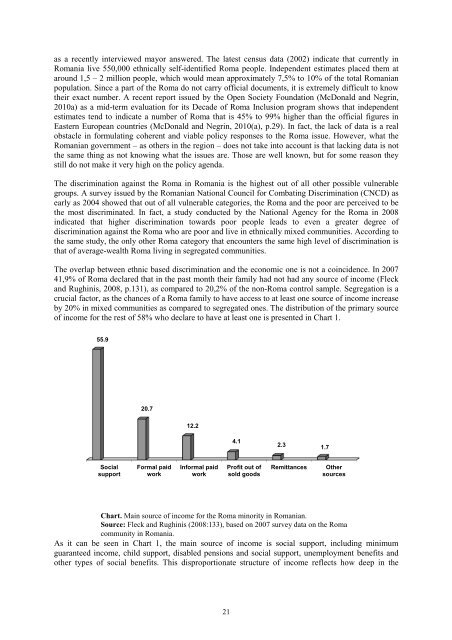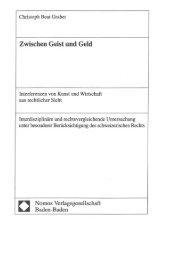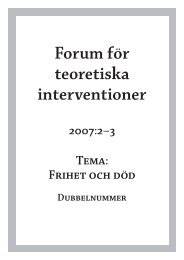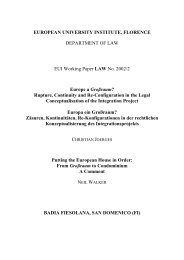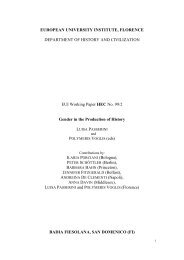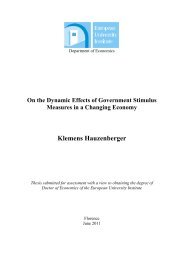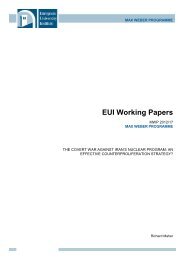Sinziana-Elena Poiana Ioana Lupea Irina-Madalina Doroftei Alina ...
Sinziana-Elena Poiana Ioana Lupea Irina-Madalina Doroftei Alina ...
Sinziana-Elena Poiana Ioana Lupea Irina-Madalina Doroftei Alina ...
Create successful ePaper yourself
Turn your PDF publications into a flip-book with our unique Google optimized e-Paper software.
as a recently interviewed mayor answered. The latest census data (2002) indicate that currently in<br />
Romania live 550,000 ethnically self-identified Roma people. Independent estimates placed them at<br />
around 1,5 – 2 million people, which would mean approximately 7,5% to 10% of the total Romanian<br />
population. Since a part of the Roma do not carry official documents, it is extremely difficult to know<br />
their exact number. A recent report issued by the Open Society Foundation (McDonald and Negrin,<br />
2010a) as a mid-term evaluation for its Decade of Roma Inclusion program shows that independent<br />
estimates tend to indicate a number of Roma that is 45% to 99% higher than the official figures in<br />
Eastern European countries (McDonald and Negrin, 2010(a), p.29). In fact, the lack of data is a real<br />
obstacle in formulating coherent and viable policy responses to the Roma issue. However, what the<br />
Romanian government – as others in the region – does not take into account is that lacking data is not<br />
the same thing as not knowing what the issues are. Those are well known, but for some reason they<br />
still do not make it very high on the policy agenda.<br />
The discrimination against the Roma in Romania is the highest out of all other possible vulnerable<br />
groups. A survey issued by the Romanian National Council for Combating Discrimination (CNCD) as<br />
early as 2004 showed that out of all vulnerable categories, the Roma and the poor are perceived to be<br />
the most discriminated. In fact, a study conducted by the National Agency for the Roma in 2008<br />
indicated that higher discrimination towards poor people leads to even a greater degree of<br />
discrimination against the Roma who are poor and live in ethnically mixed communities. According to<br />
the same study, the only other Roma category that encounters the same high level of discrimination is<br />
that of average-wealth Roma living in segregated communities.<br />
The overlap between ethnic based discrimination and the economic one is not a coincidence. In 2007<br />
41,9% of Roma declared that in the past month their family had not had any source of income (Fleck<br />
and Rughinis, 2008, p.131), as compared to 20,2% of the non-Roma control sample. Segregation is a<br />
crucial factor, as the chances of a Roma family to have access to at least one source of income increase<br />
by 20% in mixed communities as compared to segregated ones. The distribution of the primary source<br />
of income for the rest of 58% who declare to have at least one is presented in Chart 1.<br />
55.9<br />
Social<br />
support<br />
20.7<br />
Formal paid<br />
work<br />
12.2<br />
Informal paid<br />
work<br />
As it can be seen in Chart 1, the main source of income is social support, including minimum<br />
guaranteed income, child support, disabled pensions and social support, unemployment benefits and<br />
other types of social benefits. This disproportionate structure of income reflects how deep in the<br />
21<br />
4.1<br />
Profit out of<br />
sold goods<br />
2.3 1.7<br />
Remittances Other<br />
sources<br />
Chart. Main source of income for the Roma minority in Romanian.<br />
Source: Fleck and Rughinis (2008:133), based on 2007 survey data on the Roma<br />
community in Romania.


